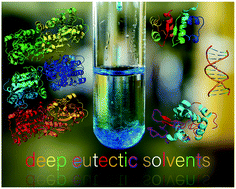The study and application of biomolecules in deep eutectic solvents
Abstract
Biomolecules have been thoroughly investigated in a multitude of solvents historically in order to accentuate or modulate their superlative properties in an array of applications. Ionic liquids have been extensively explored over the last two decades as potential replacements for traditional organic solvents, however, they are sometimes associated with a number of limitations primarily related to cost, convenience, accessibility, and/or sustainability. One potential solvent which is gaining considerable traction in recent years is the so-called deep eutectic solvent which holds a number of striking advantages, including biodegradability, inherently low toxicity, and a facile, low-cost, and solventless preparation from widely available natural feedstocks. In this review, we highlight recent progress and insights into biomolecular behavior within deep eutectic solvent-containing systems, including discussions of their demonstrated utility and prospects for the biostabilization of proteins and nucleic acids, free enzyme and whole-cell biocatalysis, various extraction processes (e.g., aqueous biphasic systems, nanosupported separations), drug solubilization, lignocellulose biomass treatment, and targeted therapeutic drug delivery. All indications point to the likelihood that these emerging solvents have the capacity to satisfy the requirements of environmental responsibility while unlocking biomolecular proficiency in established biomedical and biotechnological pursuits as well as a number of academic and industrial ventures not yet explored.

- This article is part of the themed collections: Journal of Materials Chemistry B Recent Review Articles and Journal of Materials Chemistry B HOT Papers


 Please wait while we load your content...
Please wait while we load your content...
